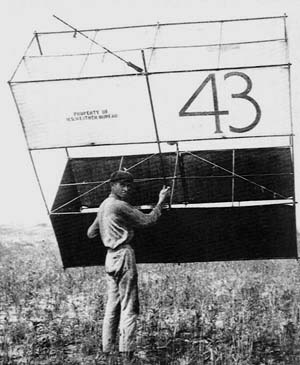
Lets Go Fly A Kite : Kites and Meteorology - A History Efforts were made as early as the 18th century to obtain meteorological measurements of the upper atmosphere. In 1749, thermometers were tied to kites for the purpose of taking upper air observations.
Efforts were made as early as the 18th century to obtain meteorological measurements of the upper atmosphere. In 1749, thermometers were tied to kites for the purpose of taking upper air observations.In 1895, Professor Charles F. Marvin, a future chief of the Weather Bureau, began experimenting with kites for routine use in the Bureau. In 1896 he perfected his kite meteorograph, an instrument capable of measuring and recording temperature, pressure and humidity. These measurements were recorded by pens tracings on paper, or on a smoked copper sheet, which was attached to a clock rotated drum.
Kites were not limited to the lower part of the troposphere. The average height of kite observations was 8,700 feet, although in 1907, one flight reached 23,111 feet, for which the Weather Bureau claimed a world record. Piano wire was used and flights were generally four to five hours. Since kites could attain great heights where there were great winds, "runaway" kites frequently caused serious problems. In one instance, the wire to a string of kites broke in south Texas. As the kites and trailing wire moved east, all telegraph lines between Dallas and Houston were cut. The Weather Bureau used kites from the late 1890s to the mid 1930s when they were replaced by airplane observations. Kites exposed many conditions in the atmosphere that were previously unknown, in particular the temperature inversion (temperature increasing with height instead of decreasing) and the existence of jet streams at various levels of the atmosphere. http://www.nws.noaa.gov/er/rlx/museum/kite.html
Return to Aerobotics Index The term Aerobotics is © Copyright 1999, CTIE © Copyright 1999 CTIE - All Rights Reserved - Caution |